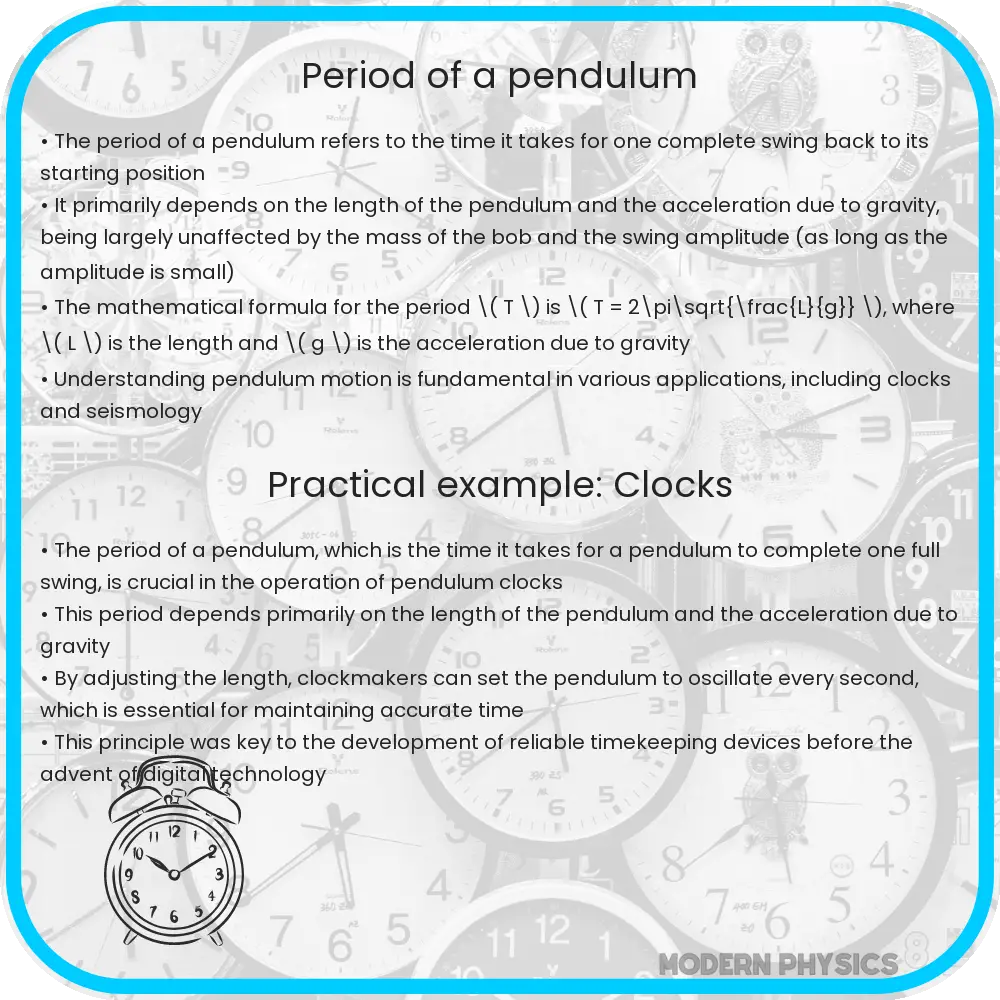Explore the dynamics of pendulum motion, including length, gravity’s impact, and advanced motion concepts, in this insightful physics article.

Understanding the Period of a Pendulum: Length, Gravity, and Motion Dynamics
The simple pendulum, a classic example in physics, illustrates fundamental principles of motion and gravity. Understanding its period – the time it takes to complete one full swing – is crucial for various applications, from clockmaking to seismology. This article delves into the factors affecting a pendulum’s period, primarily its length and the acceleration due to gravity.
Basic Pendulum Components and Motion
A simple pendulum consists of a weight, known as the bob, suspended from a fixed point with a string or rod that has negligible mass. The motion of a pendulum is a classic example of oscillatory motion, moving back and forth in a regular, repeating pattern. This motion is influenced by Earth’s gravitational pull and the length of the pendulum.
Length and Its Effect on the Pendulum’s Period
The length of the pendulum is the distance from the fixed point to the center of mass of the bob. The period of a pendulum is directly proportional to the square root of its length. As the length increases, the period also increases, meaning the pendulum takes more time to complete one full swing. The mathematical relationship is given by:
T = 2π √L/g, where T is the period, L is the length, and g is the acceleration due to gravity.
Gravity’s Role in Pendulum Dynamics
Gravity is a critical factor in pendulum motion. The acceleration due to gravity (g) varies slightly based on geographical location, affecting the pendulum’s period. In regions with stronger gravitational pull, the pendulum completes its swing faster, leading to a shorter period. This variance in gravity must be considered in precise applications, like pendulum clocks.
Constraining Factors in Pendulum Motion
While this model assumes ideal conditions, real-world factors can affect the pendulum’s period. Air resistance and the string or rod’s elasticity can introduce complexities not accounted for in the simple formula. Additionally, the amplitude of the swing (the maximum angle from the vertical) can influence the period, although this effect is negligible for small amplitudes.
In the following section, we will explore more advanced concepts related to pendulum motion, such as the effects of amplitude and how pendulum principles apply in various scientific and practical contexts.
Advanced Considerations in Pendulum Motion
Beyond the basic principles, the pendulum’s behavior incorporates more complex dynamics, especially at larger amplitudes. Unlike the idealized model, where the period remains constant regardless of amplitude, real pendulums exhibit a slight increase in period with larger swings. This phenomenon, known as amplitude dependence, can be significant in precision applications.
Energy Transfer in Pendulum Motion
The motion of a pendulum is a continuous transfer between kinetic and potential energy. At its highest points, the pendulum’s energy is entirely gravitational potential energy, while at the lowest point, it transforms into kinetic energy. This energy interplay is crucial for understanding the conservation of energy in oscillatory systems.
Pendulum Applications in Science and Technology
Pendulums have a rich history in scientific and technological applications. Historically, they were essential in timekeeping, exemplified by their use in pendulum clocks. In seismology, pendulums help in detecting and measuring earth tremors. In scientific experiments, pendulums demonstrate properties of harmonic motion and serve as tools for studying gravitational acceleration.
Mathematical Modeling and Computational Analysis
Advanced studies of pendulum motion often involve computational models. These models can simulate non-linear effects, air resistance, and variable gravitational fields, providing a more comprehensive understanding of the pendulum’s behavior in different conditions and applications.
Conclusion: The Pendulum’s Enduring Relevance
The study of pendulum motion offers more than just an understanding of a simple mechanical system. It lays the foundation for comprehending complex oscillatory and rotational motions in various physical contexts. The pendulum’s simplicity in design belies the depth of its application in timekeeping, seismology, and the fundamental study of physics. As a tool for learning, it provides a clear window into the principles of kinematics, dynamics, and energy conservation. The enduring relevance of the pendulum in both educational and practical spheres highlights its importance as a cornerstone in the study of motion and dynamics.
